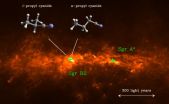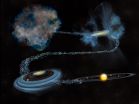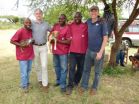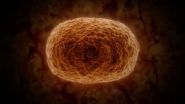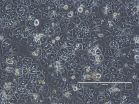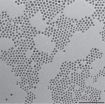(Press-News.org) Scientists from the Max Planck Institute for Radio Astronomy (Bonn, Germany), Cornell University (USA), and the University of Cologne (Germany) have for the first time detected a carbon-bearing molecule with a "branched" structure in interstellar space. The molecule, iso-propyl cyanide (i-C3H7CN), was discovered in a giant gas cloud called Sagittarius B2, a region of ongoing star formation close to the center of our galaxy that is a hot-spot for molecule-hunting astronomers. The branched structure of the carbon atoms within the iso-propyl cyanide molecule is unlike the straight-chain carbon backbone of other molecules that have been detected so far, including its sister molecule normal-propyl cyanide. The discovery of iso-propyl cyanide opens a new frontier in the complexity of molecules found in regions of star formation, and bodes well for the presence of amino acids, for which this branched structure is a key characteristic. The results are published in this week's issue of Science.
While various types of molecules have been detected in space, the kind of hydrogen-rich, carbon-bearing (organic) molecules that are most closely related to the ones necessary for life on Earth appear to be most plentiful in the gas clouds from which new stars are being formed. "Understanding the production of organic material at the early stages of star formation is critical to piecing together the gradual progression from simple molecules to potentially life-bearing chemistry," says Arnaud Belloche from the Max Planck Institute for Radio Astronomy, the lead author of the paper.
The search for molecules in interstellar space began in the 1960's, and around 180 different molecular species have been discovered so far. Each type of molecule emits light at particular wavelengths, in its own characteristic pattern, or spectrum, acting like a fingerprint that allows it to be detected in space using radio telescopes.
Until now, the organic molecules discovered in star-forming regions have shared one major structural characteristic: they each consist of a "backbone" of carbon atoms that are arranged in a single and more or less straight chain. The new molecule discovered by the team, iso-propyl cyanide, is unique in that its underlying carbon structure branches off in a separate strand. "This is the first ever interstellar detection of a molecule with a branched carbon backbone," says Holger Müller, a spectroscopist at the University of Cologne and co-author on the paper, who measured the spectral fingerprint of the molecule in the laboratory, allowing it to be detected in space.
But it is not just the structure of the molecule that surprised the team - it is also plentiful, at almost half the abundance of its straight-chain sister molecule, normal-propyl cyanide (n-C3H7CN), which the team had already detected using the single-dish radio telescope of the Institut de Radioastronomie Millimétrique (IRAM) a few years ago. "The enormous abundance of iso-propyl cyanide suggests that branched molecules may in fact be the rule, rather than the exception, in the interstellar medium," says Robin Garrod, an astrochemist at Cornell University and a co-author of the paper.
The team used the Atacama Large Millimeter/submillimeter Array (ALMA), in Chile, to probe the molecular content of the star-forming region Sagittarius B2 (Sgr B2). This region is located close to the Galactic Center, at a distance of about 27,000 light years from the Sun, and is uniquely rich in emission from complex interstellar organic molecules. "Thanks to the new capabilities offered by ALMA, we were able to perform a full spectral survey toward Sgr B2 at wavelengths between 2.7 and 3.6 mm, with sensitivity and spatial resolution ten times greater than our previous survey," explains Belloche. "But this took only a tenth of the time." The team used this spectral survey to search systematically for the fingerprints of new interstellar molecules. "By employing predictions from the Cologne Database for Molecular Spectroscopy, we could identify emission features from both varieties of propyl cyanide," says Müller. As many as 50 individual features for i-propyl cyanide and even 120 for n-propyl cyanide were unambiguously identified in the ALMA spectrum of Sgr B2. The two molecules, each consisting of 12 atoms, are also the joint-largest molecules yet detected in any star-forming region.
The team constructed computational models that simulate the chemistry of formation of the molecules detected in Sgr B2. In common with many other complex organics, both forms of propyl cyanide were found to be efficiently formed on the surfaces of interstellar dust grains. "But," says Garrod, "the models indicate that for molecules large enough to produce branched side-chain structure, these may be the prevalent forms. The detection of the next member of the alkyl cyanide series, n-butyl cyanide (n-C4H9CN), and its three branched isomers would allow us to test this idea".
"Amino acids identified in meteorites have a composition that suggests they originate in the interstellar medium," adds Belloche. "Although no interstellar amino acids have yet been found, interstellar chemistry may be responsible for the production of a wide range of important complex molecules that eventually find their way to planetary surfaces."
"The detection of iso-propyl cyanide tells us that amino acids could indeed be present in the interstellar medium because the side-chain structure is a key characteristic of these molecules", says Karl Menten, director at MPIfR and head of its Millimeter and Submillimeter Astronomy research department. "Amino acids have already been identified in meteorites and we hope to detect them in the interstellar medium in the future", he concludes.
INFORMATION:
Original Paper
Detection of a branched alkyl molecule in the interstellar medium: iso-propyl cyanide, by Arnaud Belloche, Robin T. Garrod, Holger S. P. Müller, Karl M. Menten, 2014 Science (scheduled for September 26 issue).
Interstellar molecules are branching out
Detection of iso-propyl cyanide with ALMA, the Atacama large millimeter/submillimeter array
2014-09-25
ELSE PRESS RELEASES FROM THIS DATE:
Stone Age site challenges old archaeological assumptions about human technology
2014-09-25
The analysis of artifacts from a 325,000-year-old site in Armenia shows that human technological innovation occurred intermittently throughout the Old World, rather than spreading from a single point of origin, as previously thought.
The study, published today in the journal Science, examines thousands of stone artifacts retrieved from Nor Geghi 1, a unique site preserved between two lava flows dated to 200,000–400,000 years ago. Layers of floodplain sediments and an ancient soil found between these lava flows contain the archaeological material. The dating of volcanic ...
Earth's water is older than the sun
2014-09-25
Washington, D.C.—Water was crucial to the rise of life on Earth and is also important to evaluating the possibility of life on other planets. Identifying the original source of Earth's water is key to understanding how life-fostering environments come into being and how likely they are to be found elsewhere. New work from a team including Carnegie's Conel Alexander found that much of our Solar System's water likely originated as ices that formed in interstellar space. Their work is published in Science.
Water is found throughout our Solar System. Not just on Earth, but ...
Agonizing rabies deaths can be stopped worldwide
2014-09-25
The deadly rabies virus--aptly shaped like a bullet-- can be eliminated among humans by stopping it point-blank among dogs, according to a team of international researchers led by the Paul G. Allen School for Global Animal Health at Washington State University.
Ridding the world of rabies is cost-effective and achievable through mass dog vaccination programs, the scientists report in a paper that appears in the Sept. 26 issue of Science magazine. What's more, they write, because infections occur as a result of interactions between animals and people, a "One Health" approach ...
Heritage of Earth's water gives rise to hopes of life on other planets
2014-09-25
A pioneering new study has shown that water found on Earth predates the formation of the Sun – raising hopes that life could exist on exoplanets, the planets orbiting other stars in our galaxy.
The ground-breaking research set out to discover the origin of the water that was deposited on the Earth as it formed.
It found that a significant fraction of water found on Earth, and across our solar system, predates the formation of the Sun. By showing that water is 'inherited' from the environment when a star is born, the international team of scientists believe other exoplanetary ...
Harvesting hydrogen fuel from the Sun using Earth-abundant materials
2014-09-25
VIDEO:
Science published on Sept. 25, 2014 the latest developments in Michael Grätzel's laboratory at EPFL in the field of hydrogen production from water. By combining a pair of perovskite solar...
Click here for more information.
The race is on to optimize solar energy's performance. More efficient silicon photovoltaic panels, dye-sensitized solar cells, concentrated cells and thermodynamic solar plants all pursue the same goal: to produce a maximum amount of electrons ...
Innovative Stone Age tools were not African invention, say researchers
2014-09-25
A new discovery of thousands of Stone Age tools has provided a major insight into human innovation 325,000 years ago and how early technological developments spread across the world, according to research published in the journal Science.
Researchers from Royal Holloway, University of London, together with an international team from across the United States and Europe, have found evidence which challenges the belief that a type of technology known as Levallois – where the flakes and blades of stones were used to make useful products such as hunting weapons – was invented ...
New discovery could pave the way for spin-based computing
2014-09-25
PITTSBURGH—Electricity and magnetism rule our digital world. Semiconductors process electrical information, while magnetic materials enable long-term data storage. A University of Pittsburgh research team has discovered a way to fuse these two distinct properties in a single material, paving the way for new ultrahigh density storage and computing architectures.
While phones and laptops rely on electricity to process and temporarily store information, long-term data storage is still largely achieved via magnetism. Discs coated with magnetic material are locally oriented ...
Longstanding bottleneck in crystal structure prediction solved
2014-09-25
Two years after its release, the HIV-1 drug Ritonavir was pulled from the market. Scientists discovered that the drug had crystallized into a slightly different form—called a polymorph—that was less soluble and made it ineffective as a treatment.
The various patterns that atoms of a solid material can adopt, called crystal structures, can have a huge impact on its properties. Being able to accurately predict the most stable crystal structure for a material has been a longstanding challenge for scientists.
"The holy grail of this particular problem is to say, I've written ...
Genetic 'instruction set' for antibodies knocks down hepatitis C in mice
2014-09-25
A triple-punch of antibodies both prevented hepatitis C infection and wiped out the disease after it had established itself in laboratory mice, according to a study led by Princeton University researchers. Instead of delivering the three antibodies directly, the researchers administered a genetic "instruction set" that, once in a cell, developed into antibodies that target the portions of the virus that do not mutate.
Mice treated with the antibody genetic code resisted becoming infected with hepatitis C when they were exposed to the virus, the researchers reported in ...
On the road to artificial photosynthesis
2014-09-25
The excessive atmospheric carbon dioxide that is driving global climate change could be harnessed into a renewable energy technology that would be a win for both the environment and the economy. That is the lure of artificial photosynthesis in which the electrochemical reduction of carbon dioxide is used to produce clean, green and sustainable fuels. However, finding a catalyst for reducing carbon dioxide that is highly selective and efficient has proven to be a huge scientific challenge. Meeting this challenge in the future should be easier thanks to new research results ...
LAST 30 PRESS RELEASES:
Strategic river sensors could have forewarned of Texas Camp flood disaster
Drone sampling of whale breath reveals first evidence of potentially deadly virus in Arctic
Roman soldiers defending Hadrian’s Wall infected by parasites, study finds
Pinochet’s prisoners were tormented with music but still found solace in it, a new book reveals
Fertility remains high in rural Tanzania despite access to family planning
AI-assisted device can improve autism care access
Kinetic careers
Uncovering how parasitic plants avoid attacking themselves to improve crop resistance
Nanoparticle vaccine strategy could protect against Ebola and other deadly filoviruses
Study finds brain care score can predict risk of stroke across racial groups
Key lung immune cells can intensify allergic reactions
Do hormones explain why women experience more gut pain?
New materials conduct ions in solids as easily as in liquids
Breakthrough of the Year: Renewable energy begins to eclipse fossil fuel-based sources
LLM use is reshaping scientific enterprise by increasing output, reducing quality and more
Introducing LightGen, a chip for ultra-fast, ultra-efficient generative AI
Astronomers see fireworks from violent collisions around nearby star
ACC/AHA issue new guideline on managing congenital heart disease in adults
Cosmic crash caught on camera
Is talented youth nurtured the wrong way? New study shows: top performers develop differently than assumed
Ants: An untapped resource in the development of antibiotics?
Archaeologists use AI to create prehistoric video game
Mitochondria migrate toward the cell membrane in response to high glucose levels
Tiny viral switch offers hope against drug-resistant bacteria
Most parents aware of early peanut introduction guidelines, but confused about details
HPV vaccine can protect against severe lesions of the vulva and vagina
Virtual care provision and emergency department use among children and youth
Quadrivalent HPV vaccine and high-grade vulvovaginal lesions
Insights into dry eyes gained from stem cell-derived tear glands
Researchers identify 166 human pluripotent stem cell lines available for use in clinical applications
[Press-News.org] Interstellar molecules are branching outDetection of iso-propyl cyanide with ALMA, the Atacama large millimeter/submillimeter array
